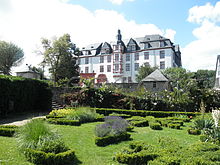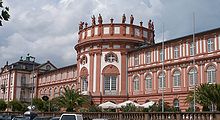Nassau-Idstein
|
Territory in the Holy Roman Empire |
|
|---|---|
| Nassau-Idstein | |
| coat of arms | |

|
|
| Alternative names | Principality of Nassau-Wiesbaden-Idstein |
| Ruler / government | Prince |
| Today's region / s | DE-HE |
| Parliament | - |
| Reichskreis | Upper Rhine Empire Circle |
| District council | - |
| Capitals / residences |
Idstein
|
| Language / n | German
|
| Incorporated into | 1721, Nassau-Ottweiler
|
Nassau-Idstein , sometimes and at times also known as Nassau-Wiesbaden-Idstein , was a territory in the Holy Roman Empire and a line of the House of Nassau . It belonged to the Upper Rhine Empire . For much of its history, the area essentially consisted of the Idstein rule and the Wiesbaden rule.
Origins
The area around Idstein lies in the Taunus . The Idstein Castle (Etichestein) was first mentioned in 1102. The area around the castle was originally an imperial fiefdom and came to the Archbishops of Mainz around 1120 . They gave the castle and its area as a fief to the ancestors of the House of Nassau , the Counts of Laurenburg. When the entire Nassau house was divided up (1255), Idstein fell to the Walram line.
In addition to Weilburg , Idstein was one of the rulers of the Walram line. Wiesbaden had temporarily slipped away from the Nassauers and could only be regained after the end of the interregnum . The Lords of Eppstein were strong opposing forces . In the 13th and beginning of the 14th century, these were also provided by some Archbishops of Mainz, which did not make the situation any easier for the Nassau people. Overall, however, their areas were too small and not closed enough to pursue a successful territorial policy. The possessions of the Counts of Diez were located between Weilburg and Idstein . There was also no connection to the Nassau ancestral lands on the lower Lahn . In this area, the Counts of Katzenelnbogen set limits to expansion.
Idstein was the residence of Walram II of Nassau . The dominion of Wiesbaden, which belonged to him, had seventeen villages, one city and two castles. The Idstein lordship had thirty-three villages and a castle. Adolf von Nassau , who later became king, obtained city rights for the Idstein settlement from King Rudolf von Habsburg in 1287 . Some of the following counts such as Gerlach I resided in Wiesbaden. This succeeded in expanding the Nassau position. In 1355 there was a division of the Walram line.
Older line
Count Adolf I got Idstein and Wiesbaden. The residence was Idstein. He had Adolfseck Castle built on the Aar . He gave this to the Archbishopric of Mainz as a fief. Basically, the Idsteiners could hardly emerge as an expansive power due to their strong neighbors Katzenelnbogen and Eppstein.
Descendants were the Archbishops of Mainz Adolf and Johann II. Walram II. Had Wallrabenstein Castle built near Idstein . Unlike the Counts of Katzenelnbogen, the Idsteiners could not benefit from the collapse of the Eppstein rule since the middle of the 15th century.
Count Johann initially took part in the war against the Electoral Palatinate on the side of Archbishop Diether von Isenburg from Mainz . But then he supported his brother Adolf in the fight for the Archbishop's chair in Mainz. As important as the various elections for members of the family to the Archbishop's chair in Mainz were, the conflicts and feuds associated with them put a heavy strain on the county's strengths.
The sons Adolf and Philipp were followers of Emperor Maximilian I. The area was divided up after the death of their father. Philipp got Idstein and Adolf III. Wiesbaden. After Philip's death, Idstein fell to his brother Adolf III. The Reformation was gradually introduced around 1542 under Count Philipp Altherr .
The Nassau-Wiesbaden-Idstein line died out in 1605. The area fell to Nassau-Weilburg . At the time of Ludwig II , the castle was partially demolished and rebuilt.
Younger line
A new line Nassau-Idstein was founded in 1629 through an inheritance under Count Johann . The property included Idstein, Wiesbaden, Sonnenberg , the Weher Grund and Burgschwalbach . The Nassau Counts were supporters of Gustav Adolf of Sweden and members of the Heilbronner Bund during the Thirty Years' War . When they refused to join the Peace of Prague in 1635 , Ferdinand II confiscated their property. The regent was therefore temporarily expelled and the country suffered from the effects of the war. The property was not restored until the Peace of Westphalia . In 1651, the Lahr rule came into his possession through an inheritance contract . Under Count Johann's rule, there were extensive witch hunts .
His successor Georg August Samuel was prince in 1688. However, this was not associated with a seat on the Reichsfürstenbank of the Reichstag . He built the Biebrich Castle near Wiesbaden and resided there for the most part. The cost of keeping the court exceeded the financial capacity of the small country. During his time, a grammar school was founded in Idstein.
Further development
After his death, Nassau-Idstein fell to Nassau-Saarbrücken and Nassau-Ottweiler in 1721 . After both lines became extinct, it belonged to Nassau-Usingen from 1728 . The Idstein lordship formed an upper office in this lordship. This consisted of the offices of Idstein, Wehen , Burgschwalbach and, together with Nassau-Diez, the office of Kirchberg . Since 1728 Idstein Castle was the seat of the archive of the Walram line of the House of Nassau. The Duchy of Nassau emerged from Nassau-Usingen in 1806 .
Regents
| Reign | Surname | born | died | Remarks |
|---|---|---|---|---|
| 1355-1370 | Adolf I. | 1307 | 1370 | Son of Count Gerlach |
| 1370-1386 | Gerlach II. | 1333 | 1386 | son |
| 1370 / 86-1393 | Walram II. | 1354 | 1393 | Brothers |
| 1393-1426 | Adolf II | 1386 | 1426 | son |
| 1426-1480 | Johann | 1419 | 1480 | son |
| 1480-1511 | Adolf III. | 1443 | 1511 | son |
| 1511-1558 | Philip I. | 1492 | 1558 | son |
| 1558-1566 | Philip II | 1516 | 1566 | son |
| 1566-1568 | Balthazar | 1520 | 1568 | Brothers |
| 1568-1596 | Johann Ludwig I. | 1567 | 1596 | son |
| 1596-1605 | Johann Ludwig II. | 1596 | 1605 | son |
| 1605-1625 | Ludwig II. | 1565 | 1627 | Passage to Nassau-Weilburg |
| 1625-1677 | Johann | 1603 | 1677 | Sohn (founder of the younger line Nassau-Idstein) |
| 1677-1721 | Georg August | 1665 | 1721 | son |
See also
- Gustav Adolf von Nassau-Idstein (1632–1664), Count of Nassau-Idstein, imperial officer and convert to the Catholic Church
literature
- FW Theodor Schliephake : History of Nassau, from the oldest times to the present. Vol. 2. Wiesbaden, 1867
Web links
- "Development of the County of Nassau before 1800" (with explanations by Uelich Reuling). Historical atlas of Hessen. In: Landesgeschichtliches Informationssystem Hessen (LAGIS).
- "Development of the Duchy of Nassau after 1800" (with explanations by Uelich Reuling). Historical atlas of Hessen. In: Landesgeschichtliches Informationssystem Hessen (LAGIS).
- History of Idstein
- Genealogy House Nassau - Walram line (PDF; 113 kB)
- Genealogy on MARDAM Royalty Guide until 1499
- Genealogy on MARDAM Royalty Guide from 1500

